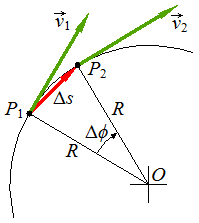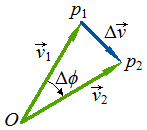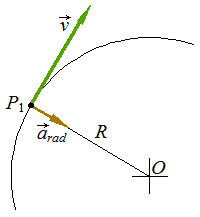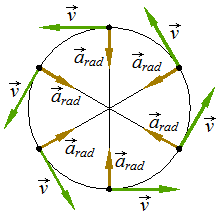Quick
Uniform circular motion is when a particle moves along a circular path with constant speed.
Equations
|
|
Uniform circular motion
|
|
|
Uniform circular motion
|
Nomenclature
| v | velocity magnitude |
| R | radius |
| t | time |
Details
Some examples of uniform circular motion are: a vehicle rounding a curve with constant radius at constant speed, a satellite moving in a circular orbit, and an ice skater skating in a circle with constant speed. There is no component of acceleration that is tangent to the path such as in non-uniform circular motion; otherwise, the speed would change. The component of acceleration perpendicular (normal) to the path, which causes the direction of the velocity to change, is related in a simple way to the speed of the particle and the radius of the circle.
This is a different problem from the consideration of projectile motion, where the acceleration is constant in both magnitude and direction. In uniform circular motion the acceleration is perpendicular to the velocity at each instant; as the direction of the velocity changes, the direction of the acceleration also changes as in Fig4. Notice that the acceleration vector at each point in the circular path is directed toward the center of the circle.
Fig1 shows a particle moving with constant speed in a circular path of radius R with the center at the origin O. The particle moves from P1 to P2 during an interval of time Δ t. The vector change in velcity Δ
v |
during this time is shown in Fig2.
The angle labeled Δφ in Fig1 and Fig2 is the same because 
v |
1 is perpendicular to the line OP1 and 
v |
2 is perpendicular to the line OP2. Therefore, the triangles OP1P2 and Op1p2 are similar. The ratios of corresponding sides are equal, so:
Δ
v |
|
| | v1 |
| = | |
or:
Δ
v |
|
| = | | Δs |
The magnitude aavg of the average acceleration during Δt is therefore:
| aavg = | Δ
v |
|
| | Δt |
| = | |
The magnitude a of the instantaneous acceleration 
a |
at point P1 is the limit of this expression as point P2 is taken closer and closer to point P1:
But the limit of Δs/Δt is the speed v1 at point P1. Also, P1 can be any point on the path, so the subscript can be dropped and v can represent the speed at any point. It follows then that:
This is the equation for uniform circular motion. The subscript "rad" is added as a reminder that the direction of the instantaneous acceleration at each point is always along the radius of a circle, toward its center. This is consistent with the acceleration vector lesson: the acceleration vector points toward the concave side of the particle's circular path, that is, toward the inside of the circle (never to the outside). Because the speed is constant, the acceleration is always perpendicular to the instantaneous velocity. This is shown in Fig3.
It is then concluded that in uniform circular motion, the magnitude a of the instantaneous acceleration is equal to the square of the speed v divided by the radius R of the circle. Its direction is perpendicular to 
v |
and inward along the radius. Because the acceleration is always directed toward the center of the circle, it is sometimes called centripetal acceleration. The word centripetal is derived from two Greek words meaning "seeking the center." Fig4 shows the directions of the velocity and acceleration vectors at several points for a particle moving with uniform circular motion. Compare this with projectile motion, in which the acceleration is always directed straight down and is not perpendicular to the path, except at one point.
The magnitude of the acceleration in uniform circular motion can also be expressed in terms of the period t of the motion, the time for one revolution (one complete trip around the circle). In a time t the particle travels a distance equal to the circumference 2πR of the circle, so its speed is:
When this is substituted into Eq1, the alternative expression is obtained:
This another equation for uniform circular motion.









